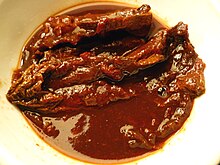Adobo
Adobo is a Spanish term that generally stands for seasoning or marinade and describes a marinade or seasoning mixture. A meat marinated or seasoned with adobo is called adobada . For example, Adobo stands for marinated dishes such as Chipotles en adobo , which consists of Chipotle chili peppers and is marinated with a rich, flavorful tomato sauce. The dish is widespread in different regions of Latin America , Mexico , Peru , Ecuador , Bolivia , the Philippines and Spain , each using pork, spices and special paprika .
Puerto Rican style Adobo
Adobo is the name given to a salt mixed with spices in Puerto Rico . Meat and fish are usually sprinkled or rubbed in before roasting, grilling or deep-frying. Supermarkets sell prepared mixes, for example under the Goya name . There are two types of adobo on the island: a moist marinade called adobo mojado , which is a mixture of chopped garlic, olive oil, salt, black pepper, dried oregano , a citrus fruit or vinegar, or a mixture of citrus fruits and vinegar , as well as a dry spice mix called Adobo Seco , which is a mix of powdered garlic, onion powder, salt, black pepper, dry oregano, and sometimes dried citrus peel. The dry mix is easier to put together and has a longer shelf life.
Filipino style adobo
In Filipino cuisine , Adobo is generally used to describe a common cooking process. When the Spaniards colonized the Filipino archipelago in the late 16th century, they encountered a local cooking method in which meat was braised with vinegar. They used the term "adobo" to refer to this process, which over time was used for all dishes prepared in this way.
The generalized term Adobo mixes the Adobo dish and the cooking process of Filipino cuisine with the general term "Adobo", which can be found in Spanish cuisine. However, both describe different things with different cultural roots. While the Filipino adobo can be viewed as a dish marinated in the Spanish sense, in Filipino parlance it is used much more specifically for certain dishes.
Typically, the Filipino Adobo is made from pork or chicken, or a combination of both. Beef, lamb or turkey are also available. The pieces of meat are slowly cooked in a sauce made from soy sauce , vinegar , ground garlic , a bay leaf and pepper and mostly fried in the oven or pan until they are brown and crispy. You can also add beans or similar vegetables. Rice or pancit , a type of fried noodle, is usually eaten as a side dish .
The dish Adobo was originally native to the northern regions of the Philippines, where dog meat used to be an important protein ingredient. It was generally used here by Filipino mountaineers and travelers as provisions and food for the way. The dish owes its relatively long shelf life to its most important ingredient, vinegar , which inhibits the growth of bacteria .
Outside of domestic use, Adobo has become a commercial term and has been adapted as a flavor aroma to other foods. A number of successful local Filipino snack products are sold with "Adobo flavor": these include nuts, chips, noodle soups and corn crackers.
The dish is also strongly associated with large Filipino communities, especially in Hawaii .
ingredients
In Latin America and the Philippines, the recipe for Adobo is relatively simple and includes just a handful of ingredients. In a tasty Adobo, none of the spices stands out; instead, the taste results from the balanced mix of the various ingredients. The most common variant is the traditional pig adobo, followed by the chicken adobo, which is generally considered to be healthier.
In addition, if the basic recipe is changed accordingly, an Adobo dish can be prepared with beef, lamb, wild fowl such as quail and snipe, with catfish, okra , eggplant , beans or water spinach. In contrast, an octopus adobo ( adobong pusit ) is completely different from the traditional adobo recipe. While most Adobo preparations have a brownish sauce, squid adobo is made with a deep purple-black sauce that is similar to the Spanish dish calamares en su tinta , which consists of squid .
Web links
- Adobo Recipes - Filipino Food Lovers
- Smoked Pata Adobo and other variations of Adobo
- Adobor recipes
- Classic Adobo recipe
- American actor / model Travis Kraft gives cooking lessons for Chicken Adobo
Individual evidence
- ↑ a b Ambeth Ocampo: Looking Back: "Adobo" in many forms " . February 24, 2009. Archived from the original on May 23, 2015. Retrieved on October 7, 2010.

